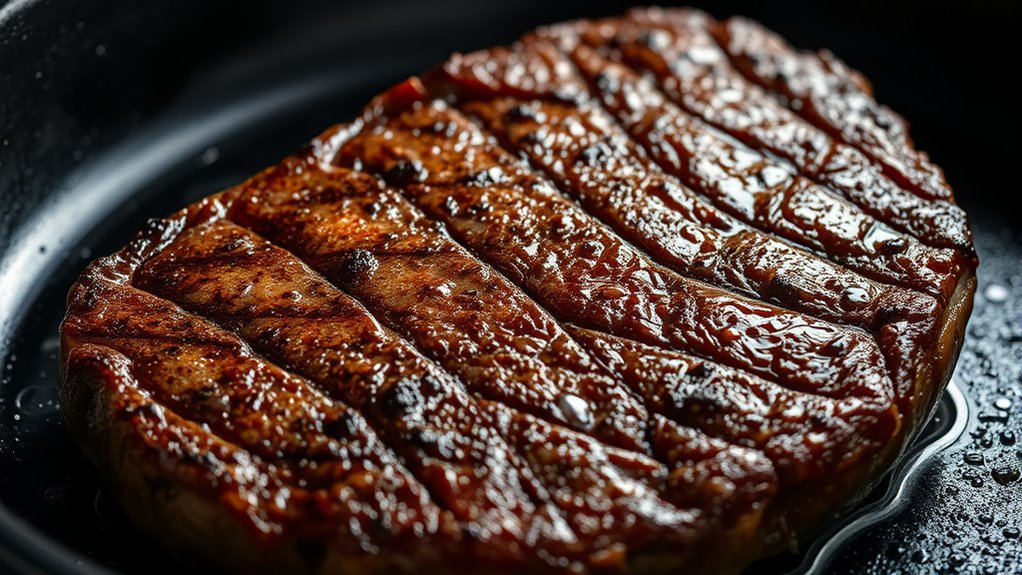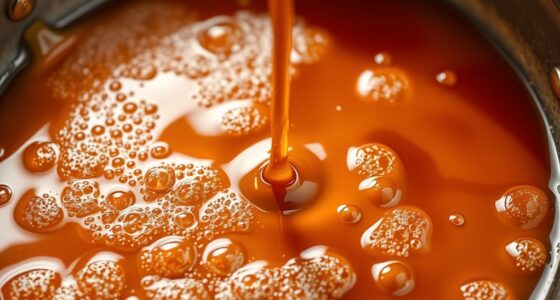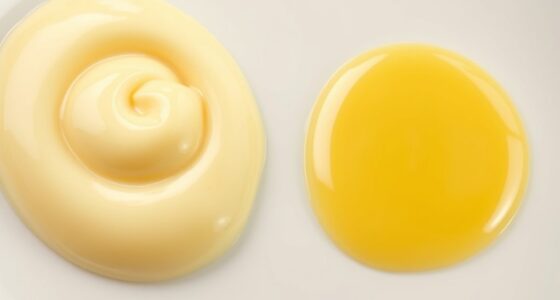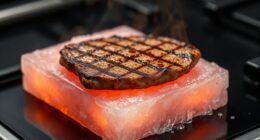The Maillard reaction is what gives your steak its delicious browning and savory flavor, especially when cooked at high heat. When you crank up the temperature, amino acids and sugars react quickly, creating new compounds that develop rich aromas, taste, and a appealing crust. This process speeds up with higher heat, making your steak more flavorful and appealing. Keep going, and you’ll discover even more about how heat transforms your cooking.
Key Takeaways
- High heat accelerates Maillard reactions, producing the rich browning and complex flavors characteristic of a perfectly seared steak.
- Elevated temperatures promote the formation of aromatic compounds, enhancing the savory, umami aroma of grilled or pan-fried steak.
- Faster reactions at high heat develop a desirable crust while preventing the steak from becoming flat or dull in flavor.
- Proper high heat controls the Maillard process, balancing flavor development without burning or overcooking the meat.
- The intense heat causes amino acids and sugars to react rapidly, creating the signature flavor depth and color of a well-cooked steak.

Have you ever wondered why browned meat or toasted bread taste so rich and savory? The secret lies in a fascinating chemical process called the Maillard reaction. When you cook foods at higher temperatures, especially over direct heat, this reaction kicks in and transforms the surface into a complex symphony of flavors. It’s not just about browning; it’s about the development of deep, savory notes that make your food irresistible.
The Maillard reaction transforms cooked foods into rich, savory flavor symphonies through high-temperature chemical magic.
The Maillard reaction occurs when amino acids, the building blocks of proteins, interact with reducing sugars present in the food. This interaction happens rapidly at temperatures above 300°F (150°C), which is why high heat is essential for creating these flavors. As the heat increases, these molecules break down and recombine, producing hundreds of new compounds. These compounds are responsible for the aroma, taste, and color changes you associate with toasted bread, seared steaks, or roasted coffee. It’s a complex cascade of chemical reactions that’s fundamental to flavor development in cooked foods. Understanding the chemical processes involved in cooking highlights how heat transforms ingredients.
While caramelization involves sugars breaking down and forming new, rich compounds, the Maillard reaction involves both sugars and proteins working together. This interplay creates a richer palette of flavors, more nuanced than either process alone. When you sear a steak, the rapid browning is a visible sign of the Maillard reaction, but it’s also a sign of the flavor-building happening beneath the surface. The higher the heat, the faster and more intensely these reactions occur, which is why chefs often prefer high heat for creating a perfect crust. Additionally, controlling temperature is crucial to achieve the desired flavor without overcooking or burning.
But it’s not just about achieving that beautiful brown color; it’s about the flavor development that comes with it. As the Maillard reaction progresses, it produces a variety of aromatic compounds that give cooked foods their distinctive, savory aromas. These compounds add depth and complexity, making every bite more satisfying. Without these reactions, your food would taste flat and dull, lacking that irresistible umami richness. That’s why controlling heat and timing is vital in cooking—too low, and the reaction stalls; too high, and you risk burning.
In essence, the Maillard reaction is what makes your grilled steak juicy and flavorful, your toasted bread crispy and tasty, and your roasted vegetables deeply satisfying. It’s a chemical dance fueled by heat, leading to the delicious flavors that turn simple ingredients into culinary delights. Recognizing the importance of high-temperature cooking helps explain why certain methods are preferred for flavor development. Proper temperature control is essential to maximize flavor compounds while avoiding undesired burning. So next time you’re searing or toasting, remember: the magic of flavor development is unfolding right before your eyes, thanks to these incredible caramelization processes.
Frequently Asked Questions
How Does the Maillard Reaction Affect the Nutritional Value of Food?
The Maillard reaction influences food’s nutritional value by slightly reducing nutrient retention, especially vitamins sensitive to heat. It also boosts antioxidant levels, which can help protect your body from oxidative stress. While some nutrients may diminish during cooking, the increased antioxidants from browning foods like grilled meat or roasted vegetables can offer added health benefits. So, enjoy the flavor and antioxidants, but don’t overdo it to preserve overall nutrient quality.
Can the Maillard Reaction Occur at Low Temperatures?
You might wonder if the Maillard reaction can happen at low temperatures. Generally, it requires higher heat to occur efficiently, so low temperature cooking has Maillard limitations. While some browning can happen slowly, it won’t develop the same flavor and color as high heat methods. To achieve that rich, browned crust, you need to crank up the heat, since low temperatures simply don’t provide enough energy for the full reaction.
Does the Maillard Reaction Produce Harmful Compounds?
Think of the Maillard reaction as a culinary dance—sometimes creating harmful partners. This reaction can produce carcinogen formation if food burns or cooks at excessively high temperatures. However, it also offers antioxidant effects that might benefit your health. So, while a perfectly browned steak can be tasty, avoid charring to minimize harmful compounds. Moderation keeps your flavorful creations both delicious and safe.
How Can I Enhance the Maillard Reaction During Cooking?
To enhance the Maillard reaction during cooking, focus on increasing the cooking temperature to around 300-350°F, which promotes browning. Make sure the surface of your food is dry, as moisture can inhibit browning. Pat your meat dry before cooking and avoid overcrowding the pan. These steps help develop a rich, flavorful crust, elevating your dish’s taste and appearance through better browning.
Is the Maillard Reaction the Same in All Types of Food?
You might think the Maillard reaction is the same across all foods, but it actually varies due to food chemistry differences. For example, meats with higher protein and sugar levels develop richer flavors, while vegetables may produce milder notes. This reaction’s effectiveness depends on factors like temperature and moisture. So, flavor development isn’t uniform—your food’s composition shapes how the Maillard reaction enhances taste.
Conclusion
Next time you cook a steak, remember that it’s not just about flavor—it’s the Maillard reaction working its magic under high heat. That perfect sear you crave? It’s a happy accident of chemistry happening right in your pan. So, when you hear that sizzle, know it’s more than just sound; it’s a delicious coincidence that transforms simple ingredients into something extraordinary. Enjoy every bite, knowing science is behind that perfect, flavorful crust.









